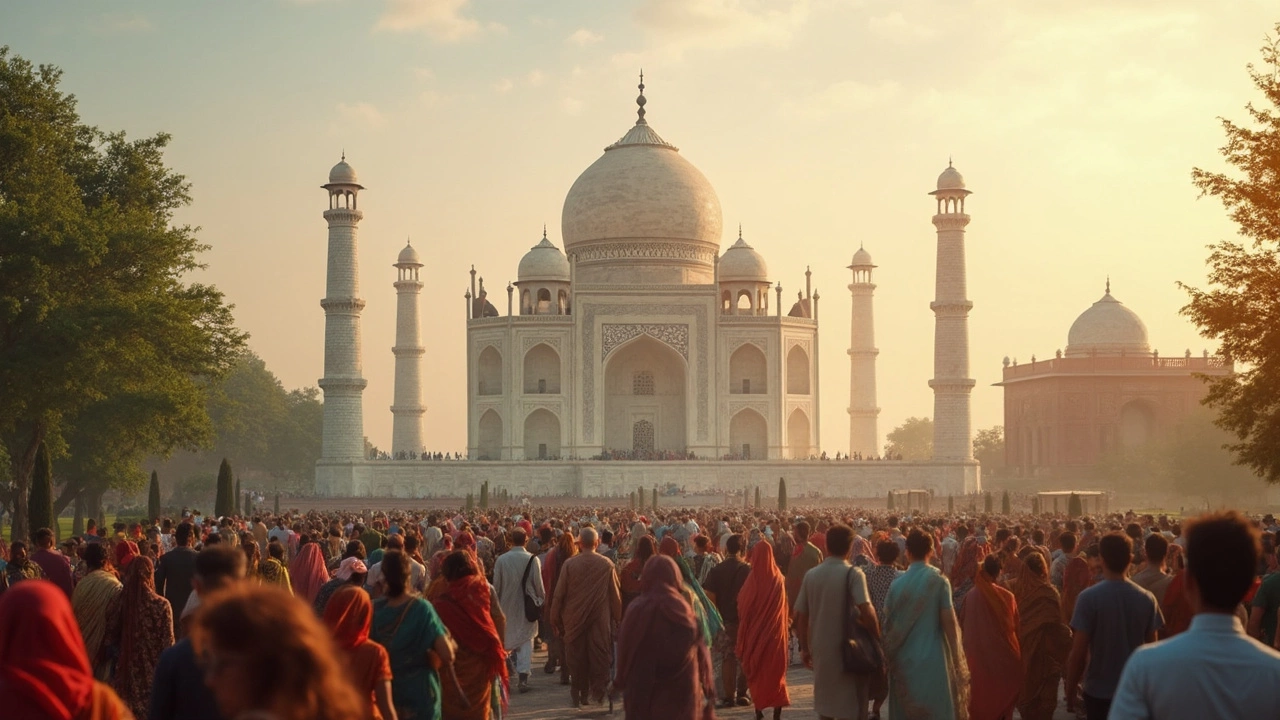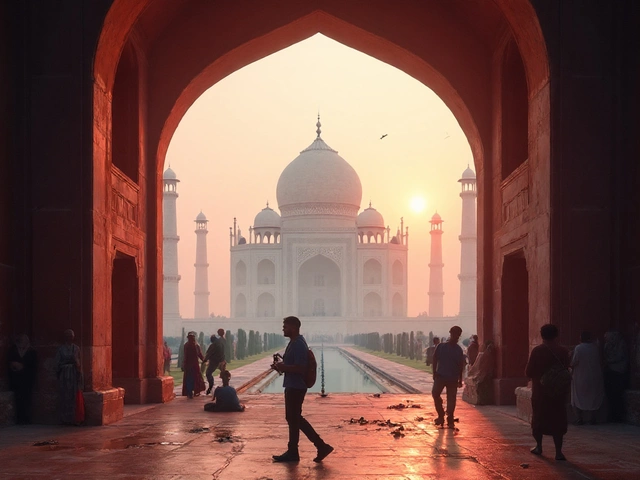Ever wondered which place in the world draws the most curious eyes? It’s not just a bragging right—it gives you a window into just how powerful some stories and buildings really are. Travel stats don’t lie, and the top spot is a fierce competition between ancient wonders and world-famous landmarks.
If you’re thinking India’s Taj Mahal makes the list, you’re right on the money. But does it clinch the global crown? The numbers sure are wild—some places see millions more visitors than entire cities get residents. When it comes to historical sites, foot traffic is skyrocketing year after year, making things both exciting and a bit chaotic for anyone planning a trip.
Want to visit and not spend hours baking in line or getting shoved around by selfie sticks? Knowing which sites are record-breakers (and when to go) can make your trip way smoother. Stick around for some real numbers and down-to-earth tips you’ll actually use—no travel agent jargon, just what you need to know.
- Chasing Crowds: Which Site Leads the Pack?
- India’s Big Contender: The Taj Mahal Story
- What Sets These Heritage Sites Apart?
- Tips for Beating the Rush at Legendary Spots
- Do Visitor Numbers Tell the Whole Story?
Chasing Crowds: Which Site Leads the Pack?
Talking numbers, the world’s most visited historical site changes depending on how you count—some folks look at ticket sales, others at turnstile clicks, and some at estimated foot traffic. Still, in recent years, one landmark usually snags the title: the Great Wall of China. This massive man-made marvel brings in a jaw-dropping 10 to 15 million visitors each year. Not far behind, France’s Eiffel Tower and the Colosseum in Rome both get over 7 million visitors yearly. In the U.S., the Statue of Liberty cracks about 4 million visits annually. India’s own pride, the Taj Mahal, welcomes about 6 to 8 million guests every year, especially during the cooler months when travelers flock in droves.
Check out how the crowd numbers stack up recently:
| Historical Site | Country | Estimated Annual Visitors (Millions) |
|---|---|---|
| Great Wall of China | China | 10-15 |
| Eiffel Tower | France | 7 |
| Taj Mahal | India | 6-8 |
| Colosseum | Italy | 7 |
| Statue of Liberty | USA | 4 |
If you’re after the most visited site, the Great Wall takes that top spot hands down. But visitor numbers can swing from year to year, especially with stuff like travel bans, weather disasters, or big events. And these numbers only tell part of the story—some sites have strict caps on daily visitors to keep things from getting out of hand, while others let crowds surge. The Taj Mahal, for example, now limits daily tourists to 40,000 on its busiest days keeping it more relaxed compared to the madness at some other spots.
Remember, dates matter. Go during an off-peak month, and you’ll dodge much of the crowd. Most visitors worldwide hit these attractions during holidays or long weekends, so aiming for a regular weekday can save you lots of time and hassle.
India’s Big Contender: The Taj Mahal Story
If you think about historical site and India in one breath, the Taj Mahal pops up first. This white marble icon in Agra isn’t just some national pride thing—it’s a global headline. Built in the 1600s by Emperor Shah Jahan as a tomb for his wife Mumtaz Mahal, the Taj has been pulling crowds for centuries. Today, it’s one of the most recognizable places on earth, showing up on bucket lists everywhere.
Even after 380 years, the Taj Mahal is still drawing in nearly 8 million curious folks every year (yep, that’s almost as many people as live in some small countries). And here’s something wild: daily entries can top 40,000 visitors during peak tourist seasons, especially around holidays or cool weather months when being outside in Agra is actually pleasant.
If you’re wondering what makes the Taj so magnetic, it’s a mix of love story, crazy architecture, and how the building seems to glow and change color depending on the time of day. It’s often named as a World Wonder and is protected as a UNESCO World Heritage Site since 1983. That label isn’t just a stamp—being “World Heritage” means constant upgrades, repairs, and, let’s be honest, some price hikes that visitors notice.
| Year | Annual Visitors | Peak Month |
|---|---|---|
| 2019 | 7.8 million | December |
| 2022 | 6.5 million | November |
| 2024 | 7.4 million | January |
Ticket prices range for locals and tourists, and there are some new rules to keep the place safer and cleaner: you can’t take big bags in, and you have to pass through security. Want a pro tip? Those sunrise tickets are worth the early alarm clock—less heat, fewer people, and epic photos. And if you’re visiting on a Friday, don’t plan on seeing the inside: the Taj Mahal is closed to the general public except for prayers in the mosque.
A quick checklist for a smoother visit:
- Buy entry tickets online to skip the main queue
- Go early morning or late afternoon for the best light and smallest crowds
- Carry water—but avoid bringing food or large bags
- Hire an audio guide or official guide for the real stories, instead of just snapping endless pictures
The Taj Mahal may not get the same numbers as the world’s busiest spots, but it’s always near the top and packs more magic into one visit than most tourist traps dream of. For anyone chasing the heart of India’s heritage, this is it.

What Sets These Heritage Sites Apart?
What makes these places magnets for travelers? It goes way beyond a pretty picture. A most visited historical site isn’t just popular—it packs stories, jaw-dropping scale, and that wow factor everyone remembers. Let’s look at some key reasons why a handful of spots totally stand out.
- Unique History: The Taj Mahal was built by Emperor Shah Jahan as a symbol of love, but it’s also a showcase of Mughal craftsmanship. Notre-Dame in Paris oozes centuries-old legend and Gothic drama. The Great Wall of China? That thing tells stories of ancient battles and dynasties that shaped a country.
- Eye-Popping Architecture: The Taj Mahal’s white marble literally changes color at sunrise and sunset. Angkor Wat has those detailed carvings and endless corridors. You don’t even have to be a history buff to feel the impact—it hits you right away.
- Accessibility: A top reason a place draws crowds: can you get there easily? The Colosseum sits right in Rome's center, close to metros and cafes. The Taj Mahal is a quick ride from New Delhi by train.
- Global Buzz: Some sites just snag the headlines. Think about how often you see the Taj Mahal or the Eiffel Tower on Instagram, travel blogs, or movies.
- Preservation and Experience: Sites that are well-kept and offer tours, guides, signs, and amenities get way more repeat buzz than those falling apart. Both safety and toilets matter.
Here’s a side-by-side for a little context on why these major sites are so irresistible:
| Site | Country | Annual Visitors (Approx.) | Why People Flock |
|---|---|---|---|
| Taj Mahal | India | 8 million | Symbol of love, jaw-dropping marble design, UNESCO World Heritage |
| Great Wall of China | China | 10 million | Massive scale, historic defense, iconic walks |
| Colosseum | Italy | 7 million | Gladiator history, Roman empire vibes, central Rome location |
| Eiffel Tower | France | 6.9 million | Paris landmark, killer city views, cultural symbol |
In short, people pick these places because they deliver something you can’t just Google: realness, epic stories, and being part of history with your own two eyes. That’s what brings visitors back, year after year.
Tips for Beating the Rush at Legendary Spots
If you want to avoid endless lines and giant crowds at the most visited historical sites, timing and strategy are everything. Sites like the Taj Mahal aren’t quiet by accident—they get slammed with up to eight million visitors a year. But you don’t have to battle the masses if you plan smart.
Here’s what actually works for places like the Taj Mahal, Red Fort, and other big-league attractions:
- Go early or late: Gates at the Taj Mahal open at 6 am. Showing up right at opening means you beat the tour buses and school groups. Late afternoon is quieter too, especially in off-season months like July or August.
- Avoid weekends and holidays: Indian national holidays and weekends are peak times. Weekdays or less popular months (May through September for India) mean smaller crowds.
- Book online: Pretty much every major site in India now has e-tickets. The Taj Mahal’s official site lets you grab tickets in advance, so you skip the long lines outside the entrance.
- Use side entrances: At the Taj, there are three gates—East, West, and South. The East Gate often has the shortest queues.
- Know the busy hours: Here’s what the crowd pattern looks like for the Taj Mahal:
| Time | Average Wait (Minutes) |
|---|---|
| 6-8 am | 5-10 |
| 9-11 am | 30-60 |
| 12-3 pm | 20-40 |
| 4-6 pm | 10-20 |
Don’t forget, several sites have restricted items—leave food, tripods, and large bags at your hotel or they’ll send you back to the end of the line. Pack light: cash, sunscreen, ID, and a water bottle (if allowed) are all you really need.
If you have flexibility, hit the most popular buildings or viewpoints first when you’re inside. The main tomb at the Taj Mahal gets packed by 9 am. Take your photos early, then wander the less crowded gardens or side buildings.
For other popular spots like Qutub Minar or Delhi’s Red Fort, the same golden rules work: online tickets, early mornings, and skipping weekends will save you hours. If you’re using a guide, get one with skip-the-line access—they’re worth every rupee when lines snake for half a kilometer.

Do Visitor Numbers Tell the Whole Story?
At first glance, the place with the most visitors looks like the automatic winner. But digging a little deeper, you realize numbers don’t always reflect what makes a site special. Sure, the most visited sites rack up eye-popping stats—spots like the Great Wall of China, Machu Picchu, and the Taj Mahal attract crowds way beyond what you’d expect. For example, the Great Wall sees over 10 million people yearly, while the Taj Mahal pulls in roughly 7 million.
Check out this rough breakdown of annual visitor numbers for a few famous sites:
| Historical Site | Country | Annual Visitors (Approx.) |
|---|---|---|
| Great Wall of China | China | 10,000,000+ |
| Louvre Museum | France | 9,000,000+ |
| Taj Mahal | India | 6,500,000 – 7,000,000 |
| Colosseum | Italy | 7,000,000 |
| Machu Picchu | Peru | 1,500,000 |
But high foot traffic doesn’t always match up with the visitor’s experience or cultural punch. Places like Machu Picchu actually have visitor limits to protect the site. Some travelers even say that less crowded, less “famous” spots give them a deeper connection to history. Also, local festivals, weather, and even movie releases can cause yearly spikes that skew the numbers.
The story behind a site, the way it’s preserved, and how you connect with it matter just as much as the crowd size. For example, the Taj Mahal’s white marble and eternal love story keep drawing folks in—not just its place in rankings. So, while numbers can help you pick a destination and know what to expect, they’re not everything. Go beyond statistics. Sometimes, the real magic is found in the quiet, tucked-away corners or at off-hours when you get the place almost to yourself.



